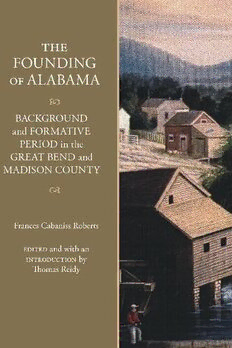
The Founding of Alabama PDF
Preview The Founding of Alabama
THE FOUNDING of ALA BAMA THE FOUNDING of ALA BAMA BACKGROUND and FORMATIVE PERIOD in the GREAT BEND and MADISON COUNTY Frances Cabaniss Roberts Edited and with an Introduction by Thomas Reidy The University of Alab ama Press Tuscaloosa The University of Alab ama Press Tuscaloosa, Ala bama 35487- 0380 uapress.ua.edu Copyright © 2019 by the University of Alab ama Press All rights reserved. Inquiries about reproducing material from this work should be addressed to the University of Ala bama Press. Typeface: Garamond Cover image: Detail of The Big Spring by William Frye, an early view of Hunts- ville in the 1850s; courtesy of the Huntsville-Madison County Public Library. Cover design: David Nees Cataloging- in- Publication data is available from the Library of Congress. ISBN: 978- 0- 8173- 2043- 0 E-I SBN: 978- 0- 8173- 9273- 4 Contents List of Figures vii Acknowledgments ix Introduction 1 1. Early Beginnings in the Great Bend 19 2. Thirst for Land in the Bend 36 3. To the Land of Milk and Honey 67 4. Boundaries and Fee- Simple Land Titles for Old Madison County 82 5. Justice and a Seat of Justice for Madison County 94 6. Madison’s Expansionists and the Expansion of Madison 103 7. Madison County’s Po liti cal Affairs: Local, Territorial, State, and National, 1810–1830 124 8. Economic and Social Development of Madison County, 1810–1830 158 9. Summary and Conclusions 187 Notes 195 Bibliography 245 Index 251 Figures Figure 1. Frances always wanted to be a teacher. On June 2, 1937, she graduated from Livingston State Teachers College, now the University of West Alab ama. 3 Figure 2. In 1956 Dr. Roberts became the first woman to earn a PhD in history at the University of Alab ama. 13 Figure 3. Between 1937 and 2000, Frances Roberts watched the city of Huntsville grow from a struggling mill town to a national leader in aeronautics and technology. 15 Figure 4. Dr. Roberts was a community leader and a frequent speaker who was involved in numerous his tori cal, charitable, and betterment programs througho ut the state. 16 Figure 5. Dr. Frances Cabaniss Roberts, 1916–2000. 17 Figure 6. Map of Madison County, Alab ama, showing origi nal Indian boundary lines and other boundary lines up to 1887. G. W. Jones & Sons, 1932. 19 Acknowledgments In spring 2017, when my good friend and fellow historian John Kvach in- troduced me to Julian Butler, a local attorney and the chair of the North Ala bama bicentennial commission, I could not have predicted the new turn my life would take. Mr. Butler suggested that we should publish Frances C. Roberts’s 1956 dissertation, “Background and Formative Period in the Great Bend and Madison County” as a book, one that would hopefully be released during 2019, Ala bama’s bicentennial year. For my part, I was very familiar with the work and with Dr. Roberts and needed no convincing on the mer- its of Butler’s proposal. The initial challenges to bringing the dissertation into the twenty- first cen- tury were mostly mechanical. The dissertation was 500 typewritten pages that needed to be converted into a Microsoft Word document. To do this, there were really only two choices: one was to use an OCR (optical character rec- ognition) reader, which is fast but imperfect; the other was to retype it. We opted for the latter and to the project’s great fortune, we were able to cajole Jessica Brodt, a doctoral student at the University of Alab ama, to work with us. Jessica did more than type pages, though. She commented on text and served as our assistant editor. Frances Roberts touched many lives on this planet, but perhaps no one knew her as well as her colleague and protégé Dr. Johanna Shields. Johanna was kind enough to read and comment on my introduction and her points were, as always, precise, salient and spot on. Additionally, as a trustee for Frances Roberts’s estate, she was designated the caretaker of all documents and papers. In this role, Dr. Shields helped shepherd the final contract through the University of Alab ama Press.
